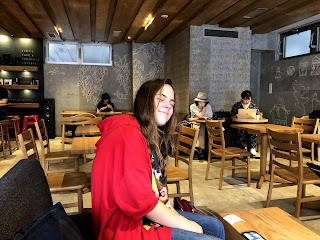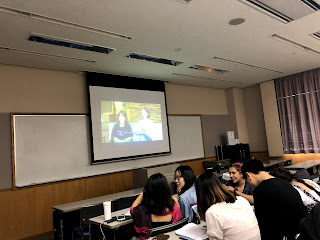
Sorry for not many photos including for today's post, but I tried to include all my feelings for this program here.
Today is the last day of the program we have task to do. Today’s task is to have individual meetings with Kristi or Julie, and then have small meetings with research groups for preparation of final presentation. This is the time to reflect on the past 4 weeks, no, actually 14 weeks of study in this program. We are all excited, while worried. Are we going to present everything we have learned through the whole process effectively? Or will we be able to share with everyone our passion on our research topics?
9 am in the morning. I heard people walking in the corridor, and I know that is the start of this decisive day. Just after finishing one week’s excursion, everyone works so hard to get back to work, to get all the work rewarded. Based on the schedule signed up one day before, people either go to the meeting room with instructors, or work on the PowerPoint by themselves, or meet up with research group members. The individual meetings are really helpful and inspiring, and it offers a great chance for us to know what is the best way to formulate the presentation, because that is the single best chance to present everything we worked so hard to go through. The meetings with research groups...As usual, we got together, anywhere we like, very casual. In the case of my research group, we met just on the 1st floor, and spent the first 10 minutes talking about each one’s process on the final presentation, and how to put everything together, emphasizing common theme as a group. While we had done most part as a group, we just began to chat...It is really interesting to learn how each group member has gone through in the past excursion week, since that is the longest free time we ever had during this program. It turned out we all explored some places interesting. At last we talked about how everyone thinks about their final presentation and the final paper. I also interviewed others about how they feel about the program generally and about the final assessment specifically. Well. Some people said this program really gave them a chance to see something that otherwise they would never go. Some said the program is really more about exploration and excursion. I also heard people saying that, Not only academics, or maybe I can say more the academics, this trip gave everyone a time to really think about themselves, their relationships with the world and other people. That is also what I think to be true. To take such a study abroad chance in university, credits and grades are important, but more than that, it is a chance to reflect and to look forward. I personally really had some experience that was so precious and inspiring for my future, both within the program and outside it into Japanese society. (@OUR NYC)

Of course, the last official academic day of this program, is far more than academics! Last chance to explore Yoyogi, Harajyuku, and maybe just NYC. After spending almost a month here, there are still some places we have never been to. Some people go to the Sakura restaurant, just on the top floor of the building we have been lived since the beginning. Everyday we saw their posters in the elevator, that you can have a bird’s eye view of Shinjyuku area, but we don’t think of going to. Some people go to the Harajyuku, just behind the NYC, to explore some shopping areas they didn’t find out before, or to try some deserts which they have been thinking about for so long, since the beginning of the program, but don’t have the chance to walk in. Or, some people go to downtown to get some gift for either our three caring and sweet instructors, to prepare for the farewell surprise to thank all they have done throughout the whole program for us. So far, the gift is ready, so excited to give to them, and say Thank You tomorrow. I myself went to Harajyuku, to visit some shops I found interesting before, and tried out some deserts. Since this is the last night here, I want to get myself some Omiyage as well.
When I got back to NYC, it is already late, and everything is dark here. Today we don’t really have major events together, but each person had a very meaningful time by themselves with small groups, to have a great ending for the whole trip. I saw some of my friends also heading back when I looked back in front of the elevator, thinking about it is soon to say goodbye, kind of sad but really appreciate all the time spent together. Looking forward to tomorrow’s presentation, hoping that is the perfect reward for us, and for everyone in the program.


























































